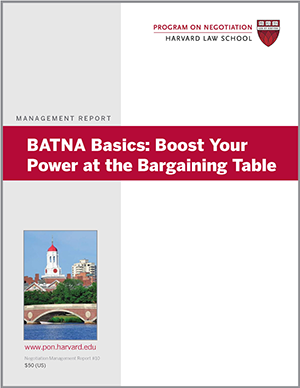
Business negotiators can get useful advice from a variety of sources, from books to blogs to training and classes—and even, as it turns out, from TV shows. As you may have noticed, negotiations frequently play out on TV: from hostage negotiators on police procedurals to fast-talking lawyers in corporate boardrooms to the real-life entrepreneurs and investors haggling on Shark Tank.
In a recent video interview with the Wall Street Journal, Program on Negotiation chair Guhan Subramanian reviewed several clips of TV negotiations from scripted shows—including The Office, Entourage, and Friends—and weighed in on the characters’ negotiation strategies. As Subramanian explains, there’s a lot we can learn from both their negotiation mistakes and triumphs.
“We Never Accept Their First Offer”
The TV negotiations begin with Michael Scott, the hapless Dunder Mifflin Paper Co. regional manager played by Steve Carell on The Office. Over the show’s nine seasons, Scott engages in a wide range of dubious negotiation behavior, including in an episode titled “Conflict Resolution,” where he babbles about ramping up win-win negotiation to the even more desirable win-win-win negotiation.
In the episode analyzed by Subramanian, Scott concludes that his fledgling Michael Scott Paper Company is on the verge of financial collapse, despite having siphoned off a number of customers from Dunder Mifflin. Dunder Mifflin CFO David Wallace (Andy Buckley) visits the Scranton branch and decides to try to buy out Scott’s company to get their clients back. In the clip, Scott and his Michael Scott Paper Company colleagues, Pam (Jenna Fischer) and Ryan (B.J. Novak), square off at the conference room table across from Wallace and Dunder Mifflin VP Charles Miner (Idris Elba).
The negotiation opens with Wallace announcing that he and Miner are prepared to make “a very generous offer.” Scott responds immediately, “And we are prepared to reject that offer.” When Ryan notes that they haven’t even heard the offer, Scott tells him, “We never accept their first offer,” then asks Wallace, “What is your second offer?”
While Scott is correct that it’s rarely a good idea to accept the first offer in a negotiation, as Subramanian notes with a chuckle, “It makes no sense” to ask to hear the second offer before you’ve heard the first offer.
Anchors Aweigh
The negotiation over the Michael Scott Paper Company continues with Wallace offering $12,000 and Scott flatly rejecting it: “Are you kidding me? That was insultingly low. I don’t even want to hear what your first offer was.”
Subramanian critiques Scott’s decision to let Wallace make the first offer: “I think in general, you should put a first offer on the table. Especially as the seller of the business, you should try to anchor the negotiation at a very high number, and that’s by putting the first offer out there.”
In a subsequent analysis of a clip from the film Intolerable Cruelty, Subramanian further explains how the anchoring effect works. “In negotiations, we’ve got a concept called ZOPA, zone of possible agreement,” he says. “When you make a first offer, you can anchor the negotiation in your favor. The research indicates that it shifts our perception of where the zone of possible agreement is.” A negotiator who is optimistic about getting a high offer might moderate their expectations after receiving an offer at the low end of the ZOPA, for instance.
BATNA Basics with Michael Scott
In The Office clip, Wallace goes on to disparage Scott’s negotiating position as the seller of a failing company. But in a burst of inspiration, Scott turns the tables by pointing out his counterpart’s weak bargaining position: “Your company is losing clients left and right. You have a stockholder meeting coming up, and you’re going to have to explain to them why your most profitable branch is bleeding.”
“As much of a buffoon as Michael Scott is,” says Subramanian, “this is a really nice move.” He goes on to explain the concept of best alternative to a negotiated agreement, or BATNA—what you will do if you don’t reach a deal with the party in the current negotiation. It’s equally important to consider “their BATNA, or what will they do if they don’t reach a deal,” Subramanian notes. “Michael Scott does a really nice job of saying, ‘Look, you think my BATNA is so bad,” he says. “Let me tell you about your BATNA.’” It’s an insightful negotiating move from a surprising source—one all of us can learn to imitate in our own difficult negotiations.
In analyses of other clips of TV negotiations, Subramanian offers advice on many topics, including whether it’s ever advisable to walk out of a negotiation, whether you should make a best-and-final offer, and how to play one offer against another in job negotiations. The wealth of negotiations and useful advice offered in the video suggests we might all benefit from supplementing formal negotiation training with plenty of couch time.
Have you taken away any helpful lessons from other TV negotiations?





